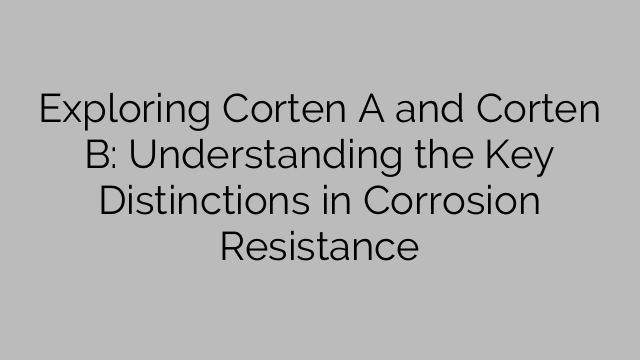Weathering steel, also known as Cor-Ten steel, is a type of steel alloy with a high resistance to atmospheric corrosion. It forms a protective rust-like layer when exposed to the elements, which not only adds to its aesthetic appeal but also acts as a strong barrier against further corrosion. This natural patina gives weathering steel a distinct orange-brown color, making it a popular choice for outdoor sculptures, building facades, and landscaping features.
Corten A and Corten B are both variations of weathering steel, but they differ in their composition and mechanical properties. Corten A is primarily composed of copper, chromium, nickel, and phosphorus, while Corten B contains additional elements such as silicon, manganese, and vanadium. These alloying elements enhance the corrosion resistance properties of the steel and also contribute to its strength and durability.
One of the key distinctions between Corten A and Corten B is their atmospheric corrosion resistance. Corten A has a higher resistance to corrosion compared to Corten B, making it suitable for more severe weather conditions. This is primarily due to the higher copper content in Corten A, which promotes the formation of a dense and stable rust-like layer. In contrast, Corten B may require additional protection in areas with high chloride concentration or acidic environments.
Another significant difference lies in their mechanical properties. Corten A has a tensile strength of at least 485 MPa and a yield strength of minimum 345 MPa, while Corten B offers slightly higher tensile strength of 520-690 MPa and a yield strength of minimum 345 MPa. Therefore, Corten B is generally recommended for structural applications that require higher strength, such as bridges or building frameworks.
When selecting between Corten A and Corten B, it is crucial to consider the specific environmental conditions and application requirements. Corten A is ideal for outdoor structures exposed to harsh weather conditions, such as coastal regions with high salt content in the air or areas with frequent rain and humidity. On the other hand, Corten B may be suitable for milder environments or projects where higher strength is desired.
It is important to note that the proper installation and maintenance of Corten steel are essential to ensure the longevity of its corrosion resistance properties. Adequate drainage, proper detailing, and periodic cleaning are necessary to prevent the accumulation of debris or moisture that can hinder the development of the protective patina.
In conclusion, Corten A and Corten B are two variations of weathering steel that offer excellent corrosion resistance and unique aesthetics. While both options are suitable for outdoor applications, understanding their key distinctions in corrosion resistance and mechanical properties is crucial for selecting the most appropriate material for specific projects. By considering factors such as environmental conditions and application requirements, architects and designers can make informed decisions to ensure the long-term durability and visual appeal of Corten steel structures.
[ad_2]

